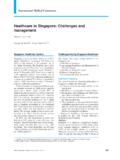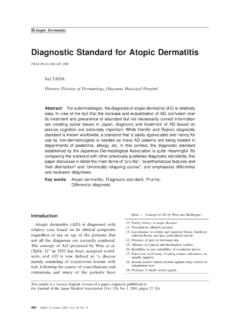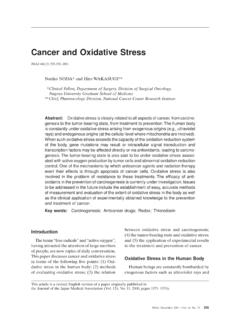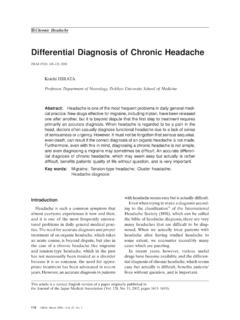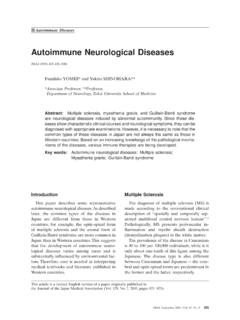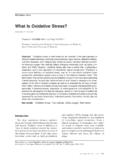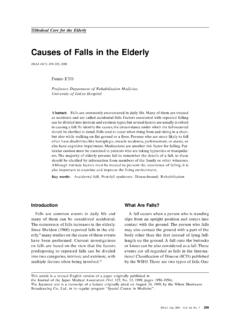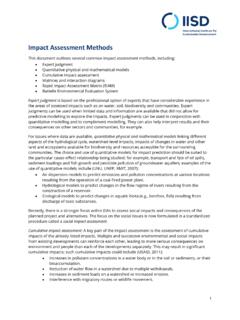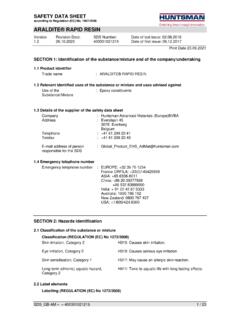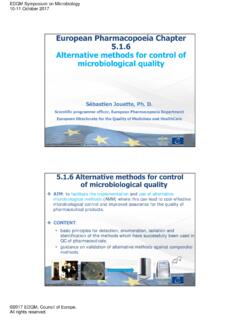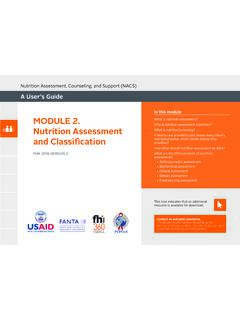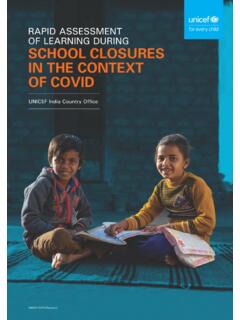Transcription of Rapid Assessment in Disasters
1 Special Feature: Comprehensive CME Program on Disaster Medicine Part 1 Conferences and LecturesJMAJ, January / February 2013 Vol. 56, No. 1 19 Why Conduct a Rapid Assessment ?A Rapid Assessment is conducted immediately after the onset of a disaster in order to locally assess the disaster-affected areas and the needs of disaster victims. As medical providers, when one is faced with catastrophic Disasters such as the Great East Japan Earthquake, the first urge is to immediately go and provide assistance. However, one must fight that initial impulse, and first conduct an initial Rapid Assessment . This is separate from immediate life saving activi- ties of the emergency search and rescue teams or disaster medical assistance teams. As indicated in the Sphere Standards, the first step in human-itarian response is to assess the needs of the affected population, and design a prioritized plan of action based on those needs.
2 By doing so, this improves the quality and speed of response. Without a Rapid Assessment , significant gaps or overlaps in assistance may occur, which not only wastes precious resources at a time of great need, but can also be a cause of further burden to the affected initial Rapid Assessment is conducted as early as a few hours after the onset of a disaster, and should be completed within 3 days at the latest. The purpose of this Assessment is not to conduct a detailed survey, but to perform a broad Assessment of the disaster and basic needs of the population in order to identify priorities for assistance. When performing the Assessment , it is advised to collect information from as many sources as possible, and to perform direct obser-vation in order to verify the data. Due to time, resource, and/or security constraints, one is often forced to rely on reports from different sources.
3 However, when one relies too much on second-ary information, significant gaps can be missed. For example, a local public health center may report that 20 latrines have been distributed, but upon direct observation, one may find that they were all out of use. This is why it is important to perform direct observation and confirm with one s own eyes as much as possible. There are other limitations of the initial Rapid Assessment that responders need to keep in mind, and these are discussed in a later Information Needs to Be Collected During a Rapid Assessment ?The checklist for a Rapid Assessment is shown in Table 1, which includes access and security, demographics of the affected population, com-munity resources, health, water, sanitation, food and non-food items, and shelters (including temporary housing).
4 In the past, the United Nations and various NGOs have prepared their own Rapid Assessment forms. Public health spe-cialists with expertise in humanitarian response at Harvard University, Johns Hopkins Univer- sity, and the American Red Cross also prepared a Rapid Assessment form when responding to Hurricane Katrina. Shown in Fig. 1 is the Rapid Assessment form that was modified specifically for use in first section on the form, access and secu- *1 Harvard Humanitarian Initiative. Lecturer, Brigham and Women s Hospital, Harvard Medical School, Boston, USA article is based on the 2012 JMAT Training Course on Disaster Medicine held on March 10, Assessment in DisastersJMAJ 56(1): 19 24, 2013 Maya ARII*1 Key words Disasters , Needs Assessment , Sphere Project, Displaced populations, ProtocolsArii M20 JMAJ, January / February 2013 Vol.
5 56, No. 1rity, assesses how safely disaster relief teams can access the affected areas. This includes accessi- bility and safety of roads as well as the risk of secondary damage from chemicals and fires, and the connectivity of phones and the second section is demographics of the affected population. This includes the total popu-lation affected, number of displaced population as well as gender breakdown and the number of children under the age of 5. The size of vul- nerable populations such as unaccompanied minors, pregnant women, immobile elderly, and dialysis or oxygen dependent population is also included in this section. The protection of unac-companied minors is a major issue especially in developing countries, as they may fall victim to kidnapping and human trafficking, and interna-tional agencies such as UNICEF are specifically assigned to account for and protect these chil-dren during for disaster-related community resources, Japan has in place highly functioning disaster-resistant infrastructures such as emergency warn-ing systems.
6 However, especially during major Disasters , assessing shelters and evacuation plans, as well as transportation and communication 1. Security and Access Route(s) to the location Damage severity Road accessibility, building collapse Secondary disaster: chemical disaster, fire Pipeline damage: gas, water, sewerage Ongoing safety and security concerns Weather conditions Phone/internet connectivity 2. Population Affected Population before disaster Number of populations displaced Estimated sex ratio Age profile: children under 5 years of age Vulnerable groups with special needs - Dialysis patients, oxygen-dependent patients, immobile elderly, unaccompanied minors, pregnant women, etc. 3. Community resources Community disaster infrastructure - Emergency warning system - Community disaster plan and drills - Pre-designated shelters Means of transportation Means of communication - Mobile phones, landlines, internet, television, radio 4 to 7.
7 Mortality and Health Impact Mortality (crude mortality rate, under 5 mortality rate) Main diseases and morbidity Damage and impact to medical facilities, staff, and supplies Public health infrastructure (surveillance, immunization) Damage to emergency medical services Child health Reproductive health (emergency obstetric care, prevention of sexual violence) 8. Water Water source Water distribution system Water storage Distance from homes to water source Water testing system 9. Sanitation Toilet facilities - Types - Number - Location (distance from shelter/housing) - Lights, locks - Maintenance - Menstrual hygiene materials Sanitation - Lavatories, buckets, warm water, shower - Privacy in bathing/washing space10. Food and Non-food items Food supply and calorie intake Cooking (self-preparation, communal kitchen) Food sources, staples, and food storage methods Essential items for daily living - Water containers, blankets, bedding/mattresses, soaps, cooking tools and equipment ( , utensils, stoves, etc.)
8 , lighting, heating/air-conditioning equipment - Electricity, gas, and gasoline supplies11. Shelter (including temporary housing) Status and need for temporary shelters Number of shelters and each capacity Covered area Availability of partitions (family-based or for different sex)Table 1 Rapid Assessment checklistRAPID Assessment IN DISASTERSJMAJ, January / February 2013 Vol. 56, No. 1 21 Fig. 1 Rapid Assessment FormSite name: Rapid Assessment Form Date of visit: Compiled by: Team: Location (Address/GIS coordinates):1. Access and security Information source Contact Main routes to location: Road access: Yes / No Building collapse? Yes / No Chemical concerns?
9 Yes / No Fires? Yes / NoDamaged pipelines: Gas: Yes / No Water: Yes / No Sewage: Yes / NoSecurity concerns? Yes / No Specify: Climate: Satellite phone? Yes / No Mobile phone? Yes / No Internet access? Yes / No2. Population Information source Contact Local population before event: Displaced population: Estimated sex ratio: % women Children <5 years: %# Unaccompanied minors: # Pregnant women: # HD-dependent: # O2-dependent: # Unaccompanied/immobile elderly: Other vulnerable groups: 3. Community resources Information source Contact Emergency warning system functioning?
10 Yes / No If yes, what type? Other available disaster infrastructure: Method(s) of transportation accessible to the affected population: Available communication infrastructure: Mobile phone Landline Internet TV Radio 4. Mortality Information source Contact Estimated # deaths within 24 hours of event: Estimated # missing: Estimated # deaths (past week): <5 years: 5 years: Overall mortality rate (all ages): deaths per persons per (recent time period)Mortality rate in children <5: deaths per children <5 years per (recent time period)Site name: 5.
